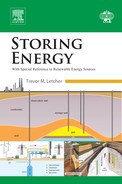References
[1] Yu N, Wang RZ, Wang LW. Prog Energy Combust Sci. 2013;39:489–514.
[2] Kousksou T, Bruel P, Jamil AT, ElRhafiki, Zeraouli Y. Sol Energy Mater Sol Cells. 2014;120:59–80.
[3] Fernandez AI, Martinez M, Segarra M, Martorell I, Cabeza LF. Sol Energy Mater Sol Cells. 2010;94:1723–1729.
[4] Kousksou T, Bedecarrats J-P, Strub F, Castaing-Lasvignottes J. Int J Energy Technol Pol. 2008;6:143–158.
[5] Kurt H, Halici F, Binark AK. Energy Convers Manage. 2000;41:939–951.
[6] Dincer I, Rosen MA. Thermal energy storage. Systems and applications. New York: Wiley; 2002.
[7] Tabor H, Matz R. Sol Energy. 1965;9:177–182.
[8] Tabor H, Weinberger Z. Non-convecting solar ponds. In: Kreider JF, Kreith F, eds. Solar energy handbook. New York: McGraw Hill; 1981: .
[9] Weinberger H. Sol Energy. 1964;8:45–56.
[10] Bansal PK, Kaushika ND. Energy Convers Manage. 1981;21:81–95.
[11] Ranjan KR, Kaushik SC. Renew Sust Energy Rev. 2014;32:123–139.
[12] Kaushika ND. Solar ponds, reference module in Earth systems and environmental sciences. Encyclopedia of Energy.; 2004. p. 651–9.
[13] El-Sebaii AA, Ramadan MRI, Aboul-Enein S, Khallaf AM. Renew Sust Energy Rev. 2011;15:3319–3325.
[14] Angeli C, Leonardi E, Maciocco L. Sol Energy. 2006;80:1498–1508.
[15] Zangrando F. Sol Energy. 1980;25:467–470.
[16] Giestas MC, Pina HL, Milhazes JP, Tavares C. Int J Heat Mass Transf. 2009;52:2849–2857.
[17] Tundee S, Terdtoon P, Sakulchangsatjatai P, Singh RA, Akbarzadeh A. Sol Energy. 2010;84:1706–1716.
[18] Akbarzadeh A, Andrews J, Golding P. Adv Sol Energy. 2005;16:233–294.
[19] Newell TA, Cowie GR, Upper JM, Smith MK, Cler GL. Sol Energy. 1990;45:231–239.
[20] Tabor HZ, Doron B. The Beith Ha’Arava 5 MW(e) solar pond power plant (SPPP). Sol Energy. 1990;45:247–253.
[21] Kumar A, Kishore VVN. Sol Energy. 1999;65:237–249.
[22] Xu H, Li SS. Acta Energiae Solaris Sinica. 1983;4:74–86.
[23] Akbarzadeh A, Andrews J, Golding P. Solar ponds. Encyclopedia of life support systems (EOLSS). Developed under the auspices of UNESCO. Oxford, UK: EOLSS Publishers; 2008. http://www.eolss.net
[24] Valderrama C, GIbert O, Arcal J, Solano P, Akbarzadeh A, Larrotcha E, Cortina JL. Desalination. 2011;279:445–450.
[25] Chepurniy N, Savage SB. Sol Energy. 1975;17:203–205.
[26] Bronicki Y. Solar ponds. Encyclopedia of Physical Science and Technology, 3rd ed. 2002. p. 149–166.
[27] Tabor H, Doron B. The Beit Ha’arava 5 MW solar pond power plant. Presented at the International Conference on Solar Ponds, Cuernavaca, Morelos, Mexico, 1987; March–April.
[28] Andrews J, Akbarzadeh A. Sol Energy. 2005;78:704–716.
[29] Leblanc J, Akbarzadeh A, Andrews J, Lu H, Golding P. Sol Energy. 2011;85:3103–3142.
[30] Harel Z, Tanny J, Tsinober A. J Sol Energy Eng. 1993;115:32–36.
[31] Taga M, Matsumoto T, Ochi T. Sol Energy. 1990;45:315–324.
[32] Wilkins E. Sol Energy. 1991;46:383–388.
[33] El-Housayni K, Wilkins E. Energy Convers Manage. 1987;27:219–236.
[34] El-Sebaii AA, Aboul-Enein S, Ramadan MRI, Khallaf AM. Sol Energy. 2013;95:30–41.
[35] Garg HP, Bandyopadhyay B, Rani U, Hrishikesan DS. Energy Convers Manage. 1982;22:117–131.
[36] Ramadan MRI, El-Sebaii AA, Aboul-Enein S, Khallaf AM. Energy Buildings. 2004;36:955–964.
[37] Casamajor AB, Parsons RE. Design guide for shallow solar ponds. Report UCRL-52385 Rev.1. Livermore, CA: Lawrence Livermore Laboratory, University of California; 1979.
[38] Einav A. Sol Energy Eng. 2004;126:921–928.
[39] El-Sebaii AA. Appl Energy. 2005;81:33–53.
[40] Lu H, Swift AHP, Hein HD, Walton JC. J Sol Energy Eng. 2004;126:759–767.
[41] Bernad F, Casas S, Gibert O, Akbarzadeh A, Cortina JL, Valderrama C. Sol Energy. 2013;98:366–374.
[42] Lu H, Walton JC, Swift AHP. Desalination. 2001;136:13–23.
[43] Agha KR. Sol Energy. 2009;83:501–510.
[44] Saleh A, Qudeiri JA, Al-Nimr MA. Energy. 2011;36:922–931.
[45] Suarez F, Tyler SW, Childress AE. Water Res. 2010;44:4601–4615.
[46] Salata F, Coppi M. Appl Energy. 2014;136:611–618.
[47] Hull JR. Sol Energy. 1980;25:33–40.
[48] Hull JR, Nielsen CE, Golding P. Salinity gradient solar ponds. Boca Raton, FL: CRC Press; 1989.
[49] Date A, Alam F, Khaghani A, Akbarzadeh A. Procedia Eng. 2012;49:42–49.
[50] Akbarzadeh A, Johnson P, Singh R. Sol Energy. 2009;83:1345–1359.
[51] Tundeea S, Srihajong NS, Charmongkolpradit S. Energy Procedia. 2014;48:453–463.
[52] Chen L, Gong J, Sun F, Wu C. Int J Therm Sci. 2002;41:95–99.
[53] Singh B, Gomes J, Tan L, Date A, Akbarzadeh A. Procedia Eng. 2012;49:50–56.
[54] Cao WH, Wu C. Brine resources and the technology of their comprehensive utilization. Beijing: Geology Publishing; 2004.
[55] Huang WH, Sun ZN, Wang XK, Nie Z, Bu LZ. Mod Chem Ind. 2008;28:14–19.
[56] Nie Z, Bu L, Zheng M, Huang W. Sol Energy. 2011;85:1537–1542.
[57] Ding CL, Ma FY, Yang RL. J Salt Chem Ind. 1997;27:17–20.
[58] Ma FY, Ding CL, Yang RL. Chem Ind Prog. 1998;4:35–38.
[59] Duffie JA, Beckman WA. Solar engineering of thermal processes. 3rd ed. Hoboken, NJ: John Wiley & Sons; 2006.
[60] Styris DL, Harling OK, Zarworski RJ, Leshuk J. Sol Energy. 1976;18:245–251.
[61] Al-Jamal K, Khashan S. Energy Convers Manag. 1998;39:559–566.
[62] Taga M, Fujimoto K, Ochi T. Sol Energy. 1996;56:267–277.



